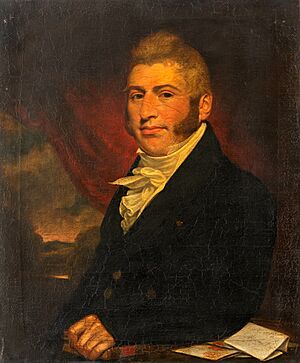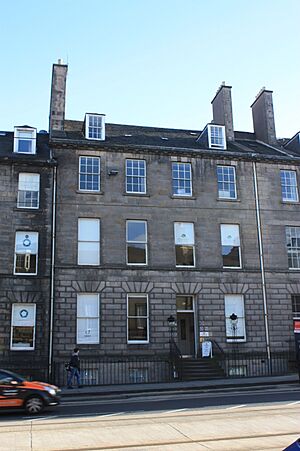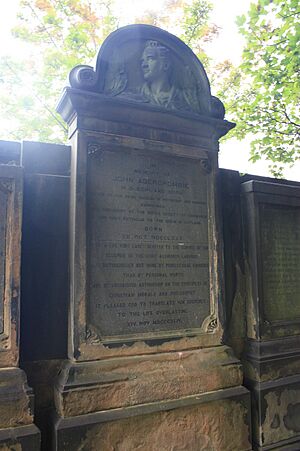John Abercrombie (physician) facts for kids
Quick facts for kids
John Abercrombie
FRSE FRCSE FRCPE
|
|
|---|---|
 |
|
| Born | 10 October 1780 |
| Died | 14 November 1844 (aged 64) Edinburgh, Scotland
|
| Alma mater | Marischal College, University of Aberdeen University of Edinburgh |
| Occupation |
|
John Abercrombie (born October 10, 1780 – died November 14, 1844) was a Scottish doctor, writer, thinker, and someone who helped others. He became one of the most successful doctors in Scotland. After another famous doctor, James Gregory, passed away, John Abercrombie was seen as the top consulting doctor in Scotland.
He worked at hospitals like the Royal Public Dispensary and the New Town Dispensary. Here, he gave free medical care to people who couldn't afford it. He also taught new doctors and medical students. John Abercrombie wrote many books about medicine. Later, he wrote about deep thoughts on life, good behavior, and religion. He was a very religious person and helped fund missionary work. He received special honors, like a medical degree from Oxford University. He was also chosen to lead Marischal College in Aberdeen and became the King's doctor in Scotland.
Contents
Growing Up in Scotland
John Abercrombie was born in Aberdeen, Scotland. He was the oldest son of Reverend George Abercrombie, a church minister. His father had a big influence on his character and beliefs.
He went to Aberdeen Grammar School and then studied at Marischal College in Aberdeen. He earned his Master of Arts degree when he was just 15 years old! After that, he went to the University of Edinburgh to study medicine. He received his medical doctorate (MD) in 1803.
A Doctor's Life
After finishing his studies, John Abercrombie went to St George's Hospital in London for more training. Then he returned to Edinburgh and started his own medical practice. His practice quickly became very popular.
In 1805, he became a surgeon at the Royal Public Dispensary. Here, he gave free medical care to poor people in the area. He also taught medical students and apprentices. He divided the city into different areas and assigned his trainees to each one. This helped him create a good training system for them. In 1816, he also became a surgeon at the new New Town Dispensary.
Keeping Detailed Notes
From the very beginning, John Abercrombie kept detailed notes on all his patients. This was quite unusual for doctors at that time. These notes became the basis for many of his medical writings. These writings helped make his reputation even stronger.
He published many papers in the Edinburgh Medical and Surgical Journal. These papers led to his more important books:
- Pathological and Practical Researches on Diseases of the Brain and Spinal Cord (1828)
- Researches on the Diseases of the Intestinal Canal, Liver and other Viscera of the Abdomen (1828)
His first book is considered the very first textbook on neuropathology, which is the study of diseases of the brain and spinal cord. In his second book, he was the first to describe the symptoms of a perforated duodenal ulcer. This is a serious condition where a hole forms in the small intestine. He was able to connect what he saw in patients with what he found after they passed away. The actual specimen of the perforated ulcer is still on display today at the Surgeons’ Hall Museum!
In 1821, he tried to become a professor at the University of Edinburgh but wasn't successful. After this, he focused on being a consulting doctor. He became a member of the Royal College of Physicians of Edinburgh in 1823.
Writing About the Mind and Morals
In his later years, John Abercrombie wrote a series of books about philosophy. In 1830, he published Inquiries concerning the Intellectual Powers and the Investigation of Truth. This was followed in 1833 by The Philosophy of the Moral Feelings. Both books became very popular. His book Inquiries is still used today in discussions about how we know what is true, especially when it comes to evidence and eyewitness accounts.
He was also an elder in the Church of Scotland. He wrote a book called The man of faith: or the harmony of Christian faith and Christian character (1835), which he gave away for free.
In 1841, John Abercrombie helped start the Edinburgh Association for sending Medical Aid for Foreign Countries. This group later became the Edinburgh Medical Missionary Society. He also gave money to support their work.
After he passed away, his book Essays (1845) about Christian ethics was published.
Awards and Recognition
John Abercrombie was the President of the Edinburgh Medico-Chirurgical Society for four years, starting in 1829. In 1831, he became a Fellow of the Royal Society of Edinburgh. He also served as the Vice-President of this society from 1835 to 1844.
The University of Oxford gave him a special honorary medical degree (MD). This was a very rare honor! In the 50 years before him, only one other person had received it, and that was Edward Jenner, who developed the smallpox vaccine. He was also chosen as the Lord Rector of Marischal College and University in Aberdeen. He became a member of the French Académie Nationale de Médecine, a famous medical academy.
Personal Life
In 1810, John Abercrombie lived at 43 York Place, Edinburgh. In 1831, he became sick with typhus while treating a colleague, but he recovered. In 1841, he became partially paralyzed, but he was still able to continue his medical practice.
He died suddenly on November 14, 1844, while getting into his carriage outside his home at 19 York Place, Edinburgh. Doctors found that he died because a blood vessel in his heart ruptured.
He is buried against the east wall of St Cuthbert's Churchyard in Edinburgh. After his death, his daughters gave his library of about 1000 books to the Royal College of Surgeons of Edinburgh.
Artistic Tributes
A sculpture (bust) of John Abercrombie, made by John Steell, is kept at the Royal College of Physicians of Edinburgh. There is also a portrait of him, painted by Benjamin Walsh in 1819, at the Royal College of Surgeons of Edinburgh.
See also
- Pathology
- List of pathologists



